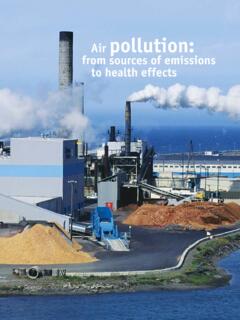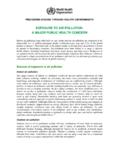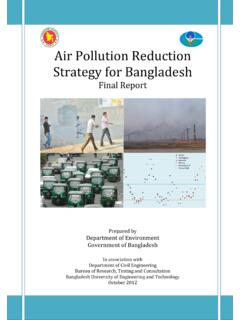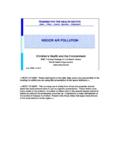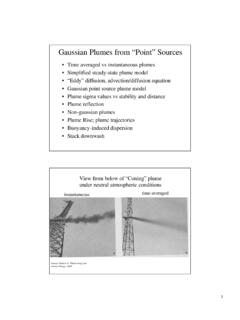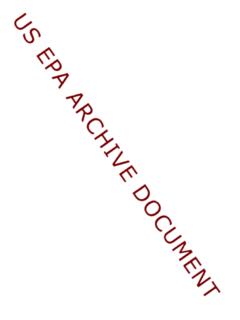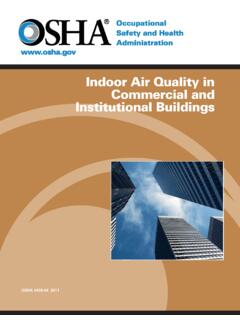Transcription of Health risks of heavy metals from long-range transboundary ...
1 Health risks OF heavy metals FROM LONG-R ANGE TR ANSBOUNDARY air pollution . The heavy metals cadmium, lead and mercury are common air pol- lutants, being emitted mainly as a result of various industrial activi- ties. Although the atmospheric levels are low, they contribute to the deposition and build-up in soils. heavy metals are persistent in the environment and are subject to bioaccumulation in food- chains. Cadmium exposures are associated with kidney and bone damage. Cadmium has also been identified as a potential human carcino- gen, causing lung cancer. Lead exposures have developmental and neurobehavioural effects on fetuses, infants and children, and ele- vate blood pressure in adults. Mercury is also toxic in the elemental and inorganic forms, but the main concern is associated with the organic compounds, especially methylmercury, that accumulate in the food-chain, in predatory fish in lakes and seas, as these are the main routes of human exposure.
2 long-range transboundary air pollution is only one source of expo- sure to these metals but, because of their persistence and poten- tial for global atmospheric transfer, atmospheric emissions affect even the most remote regions. This report, based on contributions from an international group of experts, reviews the available infor- mation on the sources, chemical properties and spatial distribu- tion of environmental pollution with cadmium, lead and mercury caused by long-range transboundary air pollution , and evaluates the potential Health risks in Europe. World Health Organization Regional Office for Europe Scherfigsvej 8, DK-2100 Copenhagen , Denmark Tel.: +45 39 17 17 17. Fax: +45 39 17 18 18. E-mail: Web site: Health risks of heavy metals from long-range transboundary air pollution Keywords AIR - standards air pollution - analysis AIR POLLUTANTS - adverse effects CHEMICALS - toxicity - adverse effects ENVIRONMENTAL MONITORING. RISK ASSESSMENT. ISBN 978 92 890 7179 6.
3 Address requests about publications of the WHO Regional Office for Europe to: Publications WHO Regional Office for Europe Scherfigsvej 8. DK-2100 Copenhagen , Denmark Alternatively, complete an online request form for documentation, Health information, or for per- mission to quote or translate, on the Regional Office web site ( ). World Health Organization 2007. All rights reserved. The Regional Office for Europe of the World Health Organization welcomes requests for permission to reproduce or translate its publications, in part or in full. The designations employed and the presentation of the material in this publication do not imply the expression of any opinion whatsoever on the part of the World Health Organization concerning the legal status of any country, territory, city or area or of its authorities, or concerning the delimitation of its fron- tiers or boundaries. Dotted lines on maps represent approximate border lines for which there may not yet be full agreement.
4 The mention of specific companies or of certain manufacturers' products does not imply that they are endorsed or recommended by the World Health Organization in preference to others of a similar na- ture that are not mentioned. Errors and omissions excepted, the names of proprietary products are distin- guished by initial capital letters. All reasonable precautions have been taken by the World Health Organization to verify the informa- tion contained in this publication. However, the published material is being distributed without warranty of any kind, either express or implied. The responsibility for the interpretation and use of the material lies with the reader. In no event shall the World Health Organization be liable for damages arising from its use. The views expressed by authors, editors, or expert groups do not necessarily represent the decisions or the stated policy of the World Health Organization. Printed in Germany Health risks of heavy metals from long-range transboundary air pollution Joint WHO/Convention Task Force on the Health Aspects of air pollution Abstract The heavy metals cadmium, lead and mercury are common air pollutants, be- ing emitted mainly as a result of various industrial activities.
5 Although the at- mospheric levels are low, they contribute to the deposition and build-up in soils. heavy metals are persistent in the environment and are subject to bioaccumula- tion in food-chains. Cadmium exposures are associated with kidney and bone damage. Cadmium has also been identified as a potential human carcinogen, causing lung cancer. Lead exposures have developmental and neurobehavioural effects on fetuses, in- fants and children, and elevate blood pressure in adults. Mercury is also toxic in the elemental and inorganic forms, but the main concern is associated with the organic compounds, especially methylmercury, that accumulate in the food- chain, in predatory fish in lakes and seas, as these are the main routes of hu- man exposure. long-range transboundary air pollution is only one source of exposure to these metals but, because of their persistence and potential for global atmos- pheric transfer, atmospheric emissions affect even the most remote regions.
6 This report, based on contributions from an international group of experts, reviews the available information on the sources, chemical properties and spatial distri- bution of environmental pollution with cadmium, lead and mercury caused by long-range transboundary air pollution , and evaluates the potential Health risks in Europe. Contents Abbreviations vi Foreword viii Executive summary x 1. Introduction 1. The process 2. Structure of the document 2. 2. Cadmium 5. Introduction 5. Pathways of human exposure and their relationships to LRTAP 21. Health hazard characterization 24. Human Health implications in relation to LRTAP 32. References 33. 3. Lead 43. Introduction 43. Pathways of human exposure and their relationships to LRTAP 56. Health hazard characterization 65. Human Health implications in relation to LRTAP 71. References 72. 4. Mercury 85. Introduction 85. Pathways of human exposure and their relationships to LRTAP 100. Health hazard characterization 104.
7 Human Health implications in relation to LRTAP 115. References 116. Annex 1 129. Working Group members and external reviewers 129. VI H E A LT H R I S K S O F H E A V Y M E T A L S F R O M L O N G - R A N G E T R A N S B O U N D A R Y A I R P O L L U T I O N. Abbreviations Organizations ATSDR Agency for Toxic Substances and Disease Registry CDC Centers for Disease Control and Prevention ( ). ECEH WHO European Centre for Environment and Health ( ). EMEP Co-operative Programme for Monitoring and Evaluation of the long-range Transmission of Air Pollutants in Europe ( ). FAO Food and Agriculture Organization of the United Nations ( ). IARC International Agency for Research on Cancer ( ). ILO International Labour Organization ( ). IPCS International Programme on Chemical Safety, a joint programme of ILO, UNEP and WHO ( ). JECFA Joint FAO/WHO Expert Committee on Food Additives MSC-E EMEP Meteorological Synthesizing Centre East ( ). MSC-HM EMEP Meteorological Synthesizing Centre heavy Metal NHANES National Health and Nutritional Examination Surveys TFMM EMEP Task Force on Measurements and Modelling ( ).
8 UNECE United Nations Economic Commission for Europe ( ). UNEP United Nations Environment Programme ( ). USEPA United States Environmental Protection Agency ( ). A B B R E V I AT I O N S VII. Technical terms ALAD -aminolevulinic acid dehydratase (an indicator of lead poisoning). B-Cd blood cadmium 2-M 2-microglobulin (protein; an indicator of tubular damage). BMDL benchmark dose level B-Pb blood lead bw body weight Cd cadmium (metallic element; atomic number 48). CdO, CdS, CdCl2 cadmium oxide, cadmium sulfide, cadmium dichloride (inorganic cadmium compounds). CI confidence interval (a measure of statistical uncertainty in numerical estimates). H-Hg mercury level in hair Hg mercury (metallic element; atomic number 80). IQ intelligence quotient (a measure of personal mental capacities). LOAEL lowest observed adverse effect level P-value statistical parameter estimating the probability of a random association Pb lead (metallic element; atomic number 82). PbO, PbSO4, PbCl2 lead oxide, lead sulfate, lead dichloride (inorganic lead compounds).
9 PTWI provisional tolerable weekly intake r correlation coefficient RGM reactive gaseous mercury U-Cd urinary cadmium VIII H E A LT H R I S K S O F H E A V Y M E T A L S F R O M L O N G - R A N G E T R A N S B O U N D A R Y A I R P O L L U T I O N. Foreword long-range transport of air pollution has been recognized as an important factor affecting ecosystems and the human population. The United Nations Economic Commission for Europe (UNECE) Convention on long-range transboundary air pollution (LRTAP) is a powerful international instrument aimed at reduc- ing and preventing air pollution . The effects of the Convention can be partly as- sessed by the reduction in emissions of pollution by the countries that are Parties to the Convention. However, more important than this is evaluation of the extent to which cuts in emissions achieved from implementation of the Convention and other actions (such as national legislation or regulations) translate into decreases in the burden of long-range transport of air pollution on the environment and human Health .
10 The Protocol on heavy metals to the UNECE Convention on long-range transboundary air pollution was signed in 1998 and came into force in 2003. The objective of the Protocol was to introduce measures for the reduction of cadmium, lead and mercury emissions into the atmosphere, with a view to pre- venting adverse effects on human Health and the environment. It describes the measures and best available techniques for controlling emissions, and indicates programmes, strategies and policies for achieving the heavy metal limit values specified in the Protocol. UNECE, the Executive Body for the Convention, at its 17th Session held in Gothenburg (29 November to 3 December 1999), requested the Joint WHO/. Convention Task Force on the Health Aspects of air pollution to assess the Health effects of cadmium, lead and mercury from LRTAP and to document the supporting scientific information on the subject. The assessment should sup- port quantification of the contribution of transboundary air pollution to human Health risks and help in defining priorities that may serve as a guide for deter- mining future monitoring and abatement strategies.










